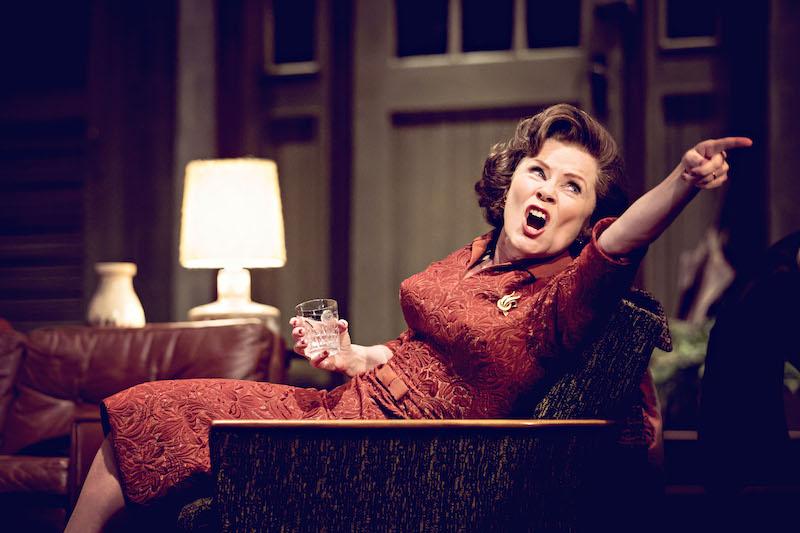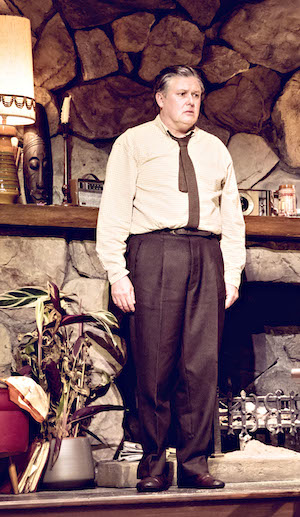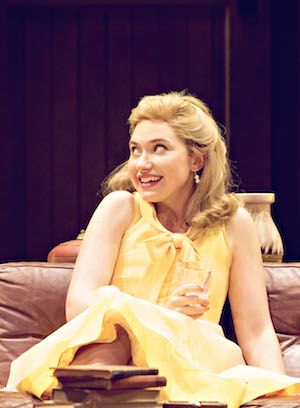Who's Afraid of Virginia Woolf?, Harold Pinter Theatre | reviews, news & interviews
Who's Afraid of Virginia Woolf?, Harold Pinter Theatre
Who's Afraid of Virginia Woolf?, Harold Pinter Theatre
Humour and vitriol contend in a tightly orchestrated production of Albee's celebrated play

Martha is described in the script of Who's Afraid of Virginia Woolf? as "a large, boisterous woman...ample but not fleshy". Imelda Staunton is petite, neat and trim, not obvious casting for the female lead in Edward Albee's most famous play. But she has formidable, coiled-spring energy and, when she wishes, a rasping voice that can cut like a hacksaw. She is less a blousy seductress, more a quick, flick-tongued viper. Martha's husband George should be "thin, hair going grey".
As a picture of a toxic marriage, James Macdonald's stylishly orchestrated West End production works as well as ever. It is 1962. George is an associate history professor in a provincial New England university where Martha's father is president. George was head of department during the war but – unfortunately for him – all his colleagues returned unscathed and his career is in the doldrums. Martha takes every opportunity to voice her disappointment in her husband, but they share a complicated fantasy, a cocoon which nevertheless provides them with ammunition against each other. Saddled with the names of the Washingtons – perhaps to suggest a wider falling apart of American, even Western, civilisation and with a teasing echo of the importance of truth-telling – they rip emotional chunks out of each other while demonstrating a painful, ultimately exclusive, closeness. For all their cruelty, they need each other and glimmers of genuine love, or at least a memory of it, steal through the vitriol.
Saddled with the names of the Washingtons – perhaps to suggest a wider falling apart of American, even Western, civilisation and with a teasing echo of the importance of truth-telling – they rip emotional chunks out of each other while demonstrating a painful, ultimately exclusive, closeness. For all their cruelty, they need each other and glimmers of genuine love, or at least a memory of it, steal through the vitriol.
The title was among graffiti Albee had seen years earlier scrawled on a mirror in a Greenwich Village bar. He thought it a good academic joke, a play on "Who's afraid of the Big Bad Wolf?" which he interpreted as "who's afraid of living life without false illusions?" False illusions are at the core of this play.
One Saturday night, after a faculty party, Martha invites a new member of the academic staff to their dull campus house (designed in mud colours by Tom Pye) for drinks. Nick, a biologist, is blond, good looking and an accomplished boxer; his giggly wife, Honey, is naive, mousy and given to puking. They are a necessary audience for the play-flaying but are also drawn into it as Martha humiliates George by flirting outrageously with Nick and George in turn takes his revenge. Luke Treadaway and Imogen Poots (pictured below) give the younger couple, playing their own games of pretended perfection, real presence in a paler version of their hosts' imprisoning marriage. Albee said more than once that he could think of nothing worse than reaching the end of life and realising you hadn't really lived it. This alcohol-fuelled quartet seem bent on just such an outcome. Disappointment – about status, about children – dogs both couples. Male competitiveness simmers. Macdonald's production also makes clear the power of one generation over the next. It is no accident that George deals in the past, history, and Nick in the future, science. And the personality of the wife's father looms large over both couples.
Albee said more than once that he could think of nothing worse than reaching the end of life and realising you hadn't really lived it. This alcohol-fuelled quartet seem bent on just such an outcome. Disappointment – about status, about children – dogs both couples. Male competitiveness simmers. Macdonald's production also makes clear the power of one generation over the next. It is no accident that George deals in the past, history, and Nick in the future, science. And the personality of the wife's father looms large over both couples.
Albee, who died in September 2016, once said the play (and later the 1966 film starring Elizabeth Taylor and Richard Burton which won five Oscars) "hung about my neck like a shining medal of some sort – really nice but a trifle onerous." In later years, having won three Pulitzer Prizes and numerous awards, he went on to a late-flowering period, including The Goat or Who Is Sylvia?, soon to open in London, but Who's Afraid of Virginia Woolf? still shines as his landmark play.
Staunton and Hill, although unusual casting (but sanctioned by Albee himself) present a couple who are equals in intelligence, malignity and mutual need and who know exactly how to hurt each other. They are also both brilliant comic performers: Hill's laconic, snide precision is a perfect complement to Staunton's louche loudness and they find every scrap of poisonous humour in a tight, toxic duet. The stripping away of the delusion by which they have lived (and even after more than half a century it seems necessary not to spell it out) causes an unforgettable animal howl from Staunton; for the moment George has won.
The future of Arts Journalism
You can stop theartsdesk.com closing!
We urgently need financing to survive. Our fundraising drive has thus far raised £49,000 but we need to reach £100,000 or we will be forced to close. Please contribute here: https://gofund.me/c3f6033d
And if you can forward this information to anyone who might assist, we’d be grateful.

Subscribe to theartsdesk.com
Thank you for continuing to read our work on theartsdesk.com. For unlimited access to every article in its entirety, including our archive of more than 15,000 pieces, we're asking for £5 per month or £40 per year. We feel it's a very good deal, and hope you do too.
To take a subscription now simply click here.
And if you're looking for that extra gift for a friend or family member, why not treat them to a theartsdesk.com gift subscription?
more Theatre
 Ragdoll, Jermyn Street Theatre review - compelling and emotionally truthful
Katherine Moar returns with a Patty Hearst-inspired follow up to her debut hit 'Farm Hall'
Ragdoll, Jermyn Street Theatre review - compelling and emotionally truthful
Katherine Moar returns with a Patty Hearst-inspired follow up to her debut hit 'Farm Hall'
 Troilus and Cressida, Globe Theatre review - a 'problem play' with added problems
Raucous and carnivalesque, but also ugly and incomprehensible
Troilus and Cressida, Globe Theatre review - a 'problem play' with added problems
Raucous and carnivalesque, but also ugly and incomprehensible
 Clarkston, Trafalgar Theatre review - two lads on a road to nowhere
Netflix star, Joe Locke, is the selling point of a production that needs one
Clarkston, Trafalgar Theatre review - two lads on a road to nowhere
Netflix star, Joe Locke, is the selling point of a production that needs one
 Ghost Stories, Peacock Theatre review - spirited staging but short on scares
Impressive spectacle saves an ageing show in an unsuitable venue
Ghost Stories, Peacock Theatre review - spirited staging but short on scares
Impressive spectacle saves an ageing show in an unsuitable venue
 Hamlet, National Theatre review - turning tragedy to comedy is no joke
Hiran Abeyeskera’s childlike prince falls flat in a mixed production
Hamlet, National Theatre review - turning tragedy to comedy is no joke
Hiran Abeyeskera’s childlike prince falls flat in a mixed production
 Rohtko, Barbican review - postmodern meditation on fake and authentic art is less than the sum of its parts
Łukasz Twarkowski's production dazzles without illuminating
Rohtko, Barbican review - postmodern meditation on fake and authentic art is less than the sum of its parts
Łukasz Twarkowski's production dazzles without illuminating
 Lee, Park Theatre review - Lee Krasner looks back on her life as an artist
Informative and interesting, the play's format limits its potential
Lee, Park Theatre review - Lee Krasner looks back on her life as an artist
Informative and interesting, the play's format limits its potential
 Measure for Measure, RSC, Stratford review - 'problem play' has no problem with relevance
Shakespeare, in this adaptation, is at his most perceptive
Measure for Measure, RSC, Stratford review - 'problem play' has no problem with relevance
Shakespeare, in this adaptation, is at his most perceptive
 The Importance of Being Earnest, Noël Coward Theatre review - dazzling and delightful queer fest
West End transfer of National Theatre hit stars Stephen Fry and Olly Alexander
The Importance of Being Earnest, Noël Coward Theatre review - dazzling and delightful queer fest
West End transfer of National Theatre hit stars Stephen Fry and Olly Alexander
 Get Down Tonight, Charing Cross Theatre review - glitz and hits from the 70s
If you love the songs of KC and the Sunshine Band, Please Do Go!
Get Down Tonight, Charing Cross Theatre review - glitz and hits from the 70s
If you love the songs of KC and the Sunshine Band, Please Do Go!
 Punch, Apollo Theatre review - powerful play about the strength of redemption
James Graham's play transfixes the audience at every stage
Punch, Apollo Theatre review - powerful play about the strength of redemption
James Graham's play transfixes the audience at every stage
 The Billionaire Inside Your Head, Hampstead Theatre review - a map of a man with OCD
Will Lord's promising debut burdens a fine cast with too much dialogue
The Billionaire Inside Your Head, Hampstead Theatre review - a map of a man with OCD
Will Lord's promising debut burdens a fine cast with too much dialogue

Add comment